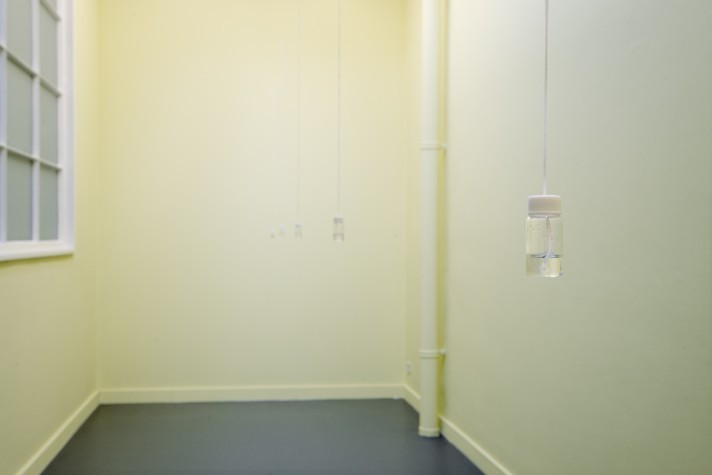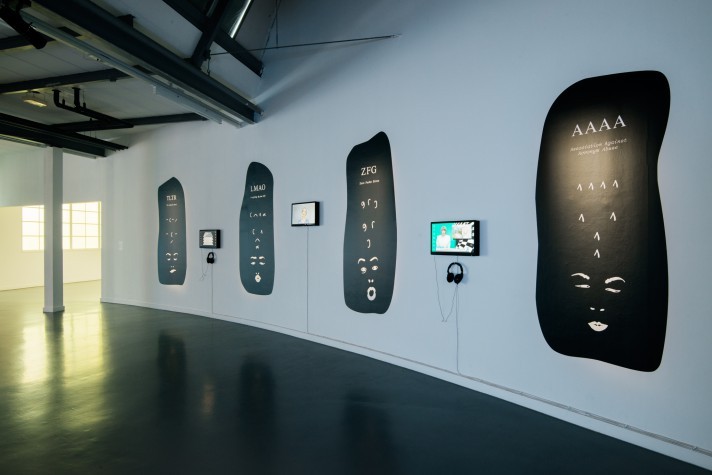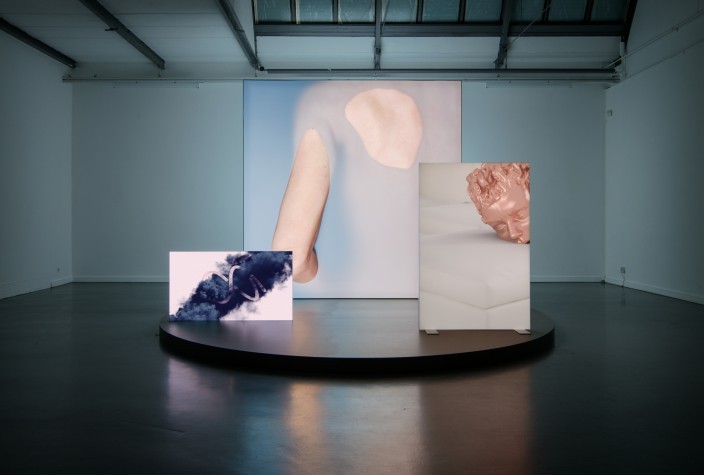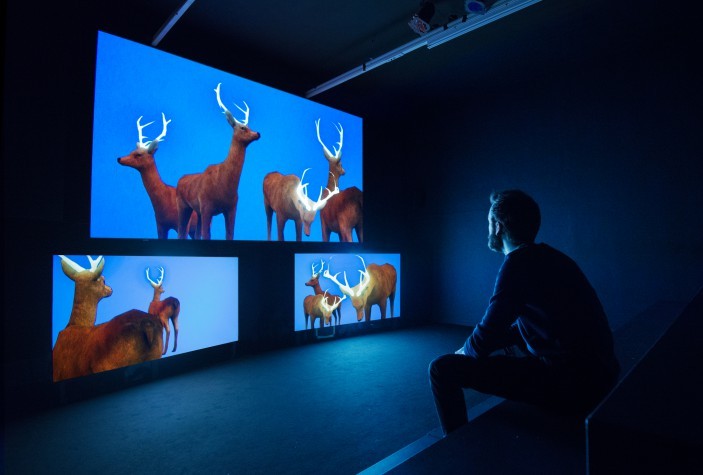Spending Quality Time With My Quantified Self
11 Feb - 10 Apr 2016

Maki Ueda - Deconstructing Body Odeur (and Reconstructing) - 2016 (installation view in TENT Rotterdam) Photo Sander van Wettum

Miloš Trakilović - Nothing Really Matters - 2015 (installation view in TENT Rotterdam) Photo Sander van Wettum

Amy Suo Wu - TLTRNW - 2015 (Spending Quality Time With My Quantified Self installation view in TENT Rotterdam) Photo Sander van Wettum
SPENDING QUALITY TIME WITH MY QUANTIFIED SELF
Momu & No Es, Anni Puolakka & Jenna Sutela, Jenna Sutela, Amy Suo Wu, Anna Zett, Kate Cooper, Alexandra Navratil, Miloš Trakilović, Maki Ueda
11 February – 10 April 2016
curated by Niekolaas Johannes Lekkerkerk and Jesse van Oosten.
Digital technology is increasingly becoming integrated into our daily lives. Using apps, digital extensions, and portable measuring equipment, we collect information about our performance, endurance, and ourselves. Spending Quality Time With My Quantified Self collates a number of artistic positions, key to which are the embodiment of the human, the body-to-be, and the body with which we are inextricably linked to our digital society and data economy.
In a world increasingly determined by calculations, data, and information, the ‘quantified self’ can be seen, through software-driven infrastructure, as symptomatic of the current zeitgeist, which is marked by fleeting relationships and an accelerated sense of time. Our digital bodies and identities have become part of an economy of clicks, tracks, traces, and likes, where a few powerful companies capitalise on content personally generated by its users. Will this interaction between the human body and digital technology contribute to a more insightful and qualitative sense of self and identity? Digital extensions and bodily prostheses often provide solutions to certain aspects of daily life, but what areas lie beyond the scope of a techno-fix for an optimised life?
These days it seems ever more difficult to distinguish between the virtual and physical worlds. Digital processes are ubiquitous and deeply entrenched in the structure of our everyday private and working lives. Artist duo Momu & No Es zero in on this fact in their video installation Highway, which presents a parallel digital universe in which there is no longer any distinction between tangible and digital reality. In a similar way, Miloš Trakilović examines the interrelationship between the digital world and the human body. For this exhibition, he has developed a series of prints and a lecture performance that uses a number of exercises based on military manoeuvres and a story of an escape over a mountain range to examine the limitations and dimensions of the human body.
In this ambiguous hybrid world, the human body is part of a network connecting it to its environment. Jenna Sutela explores this relationship in her science fiction video essay When You Moved, which looks at the frictions between technological and bodily time and experience. The video explores the various ways in which we subject our way our life to technology and how, as a result, the body develops an increasingly isolated and passive relationship to its surroundings. In a similar way, Kate Cooper’s installation Experiments in Absorption raises the question of what it means to be immersed in an environment, a material, or someone else’s emotions. Meanwhile, in her video artwork Revitalise, Alexandra Navratil reflects on how ergonomic and thermodynamic norms affect the performance of the human body in working situations. Olfactory artist Maki Ueda, on the other hand, explores an area of bodily experience that escapes digitalization: she has devised an installation that attempts to index the phenomenon of sweat and the various types of human body odour – a subjective area that cannot be captured in statistics or digital data.
Technology influences not only the fabric of human existence, but also the way we communicate about it. In this era of fragmentation, in which written language is increasingly being supplemented by visuals or specially adapted forms of communication such as emoticons, graphic designer and artist Amy Suo Wu’s TLTRNW (Too Long To Read And Write) project focuses on the way we use language to assume an identity and how that identity is influenced by technology. Spoken language does not escape codification either. Anna Zett’s Text-to-Speech sound piece is devoted to the standardised, universal language of text-to-speech software (often used for voice-overs), in which the voice has an autonomous existence, independent of the human body. And designers and artists Anni Puolakka & Jenna Sutela use their audio essay and installation Attention Spa to explore untraceable and uncodifiable forms of language. Immersed in water, they examine the situation from a technological, material and interconnected perspective, with a particular focus on the sensory and non-quantifiable.
Momu & No Es, Anni Puolakka & Jenna Sutela, Jenna Sutela, Amy Suo Wu, Anna Zett, Kate Cooper, Alexandra Navratil, Miloš Trakilović, Maki Ueda
11 February – 10 April 2016
curated by Niekolaas Johannes Lekkerkerk and Jesse van Oosten.
Digital technology is increasingly becoming integrated into our daily lives. Using apps, digital extensions, and portable measuring equipment, we collect information about our performance, endurance, and ourselves. Spending Quality Time With My Quantified Self collates a number of artistic positions, key to which are the embodiment of the human, the body-to-be, and the body with which we are inextricably linked to our digital society and data economy.
In a world increasingly determined by calculations, data, and information, the ‘quantified self’ can be seen, through software-driven infrastructure, as symptomatic of the current zeitgeist, which is marked by fleeting relationships and an accelerated sense of time. Our digital bodies and identities have become part of an economy of clicks, tracks, traces, and likes, where a few powerful companies capitalise on content personally generated by its users. Will this interaction between the human body and digital technology contribute to a more insightful and qualitative sense of self and identity? Digital extensions and bodily prostheses often provide solutions to certain aspects of daily life, but what areas lie beyond the scope of a techno-fix for an optimised life?
These days it seems ever more difficult to distinguish between the virtual and physical worlds. Digital processes are ubiquitous and deeply entrenched in the structure of our everyday private and working lives. Artist duo Momu & No Es zero in on this fact in their video installation Highway, which presents a parallel digital universe in which there is no longer any distinction between tangible and digital reality. In a similar way, Miloš Trakilović examines the interrelationship between the digital world and the human body. For this exhibition, he has developed a series of prints and a lecture performance that uses a number of exercises based on military manoeuvres and a story of an escape over a mountain range to examine the limitations and dimensions of the human body.
In this ambiguous hybrid world, the human body is part of a network connecting it to its environment. Jenna Sutela explores this relationship in her science fiction video essay When You Moved, which looks at the frictions between technological and bodily time and experience. The video explores the various ways in which we subject our way our life to technology and how, as a result, the body develops an increasingly isolated and passive relationship to its surroundings. In a similar way, Kate Cooper’s installation Experiments in Absorption raises the question of what it means to be immersed in an environment, a material, or someone else’s emotions. Meanwhile, in her video artwork Revitalise, Alexandra Navratil reflects on how ergonomic and thermodynamic norms affect the performance of the human body in working situations. Olfactory artist Maki Ueda, on the other hand, explores an area of bodily experience that escapes digitalization: she has devised an installation that attempts to index the phenomenon of sweat and the various types of human body odour – a subjective area that cannot be captured in statistics or digital data.
Technology influences not only the fabric of human existence, but also the way we communicate about it. In this era of fragmentation, in which written language is increasingly being supplemented by visuals or specially adapted forms of communication such as emoticons, graphic designer and artist Amy Suo Wu’s TLTRNW (Too Long To Read And Write) project focuses on the way we use language to assume an identity and how that identity is influenced by technology. Spoken language does not escape codification either. Anna Zett’s Text-to-Speech sound piece is devoted to the standardised, universal language of text-to-speech software (often used for voice-overs), in which the voice has an autonomous existence, independent of the human body. And designers and artists Anni Puolakka & Jenna Sutela use their audio essay and installation Attention Spa to explore untraceable and uncodifiable forms of language. Immersed in water, they examine the situation from a technological, material and interconnected perspective, with a particular focus on the sensory and non-quantifiable.




